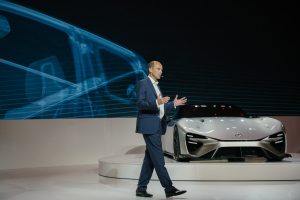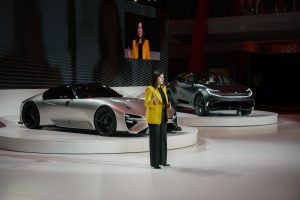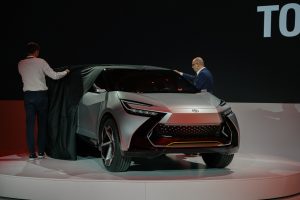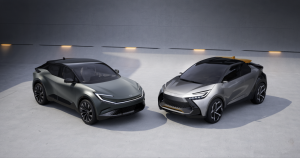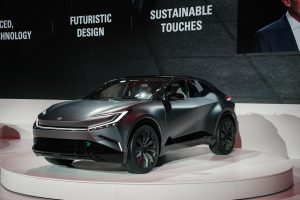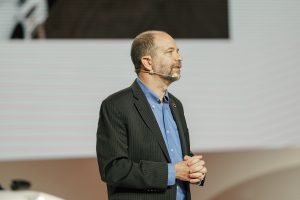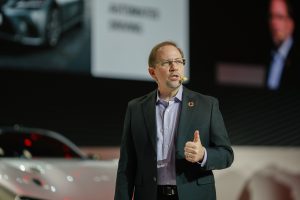Toyota on track to achieve carbon neutrality in Europe by 2040
- Toyota Motor Europe (TME) outlines its path to achieving full carbon neutrality by 2040 at its annual Kenshiki media presentation
- New Toyota and Lexus battery electric and plug-in hybrid electric concepts revealed
- Toyota to start European battery assembly to supply its new Toyota C-HR prologue plug-in hybrid electric vehicle
- Woven Planet shares Toyota’s ‘Software First’ approach to accelerate electrified vehicle development and provides further insights on Woven City, a “test track for mobility”
- Toyota’s market share increases to a record 7.3 per cent in Europe in 2022, rising 0.9 percentage points year-on-year as the company consolidates is position as the number two best-selling car brand in Europe
Toyota has announced its commitment to achieve full carbon neutrality in Europe by 2040 at the latest. This key message was delivered at Toyota Motor Europe’s (TME) annual Kenshiki presentation, delivered to more than 250 media representatives in Brussels last week and made public today.
Building on the undertaking given last year to deliver 100 per cent CO2 reduction in all Toyota’s new vehicles in the EU, UK and EFTA by 2035, Matt Harrison, President and CEO of Toyota Motor Europe summarised the company’s direction: “Broadly speaking, there are two focus areas: the first is carbon neutrality and how we plan to achieve it in areas of our business, and the second is the future of mobility, as we transition from a manufacturing and sales company to a provider of mobility services.”
Marvin Cooke, EVP Manufacturing of Toyota Motor Europe, outlined the company’s objective to make all its European manufacturing facilities carbon-neutral by 2030. In this area, the approach is multi-faceted: minimising energy consumption wherever possible, switching to green energy and implementing numerous kaizen (continuous improvement) innovations which reduce or eliminate CO2.
He said: “At our engine plant in Deeside in the UK we have installed solar panels equivalent to 10 football pitches to give us a good supply of zero emission electricity, and we’re collaborating with a local company to process more than 90% of our waste to generate biogas which will be used to produce green electricity and biomethane. This approach is working well and we expect to be carbon neutral as early as 2025. Towards 2040 for those activities outside of TME’s direct control, such as upstream supply and logistics, it’s a much bigger challenge and one we will achieve in close collaboration with our partners and suppliers.”
‘The power of And’ – the science behind Toyota’s multi-technology strategy
Dr Gill Pratt, Chief Scientist of Toyota Motor Corporation and CEO of Toyota Research Instituteprovided practical insights into the hard science behind Toyota’s global approach to decarbonisation. This uses multiple electrified technologies and optimises the use of scarce resources to maximise carbon reduction. Toyota’s multi-technology strategy recognises the complementary benefits of both battery-powered vehicles and those which run on hydrogen for zero emission mobility. He explained how, because of the current short supply and high costs of battery materials and the lack of infrastructure, it is better to use a combination of battery electric, plug-in hybrid electric and hybrid electric vehicles to reduce CO2 emissions over the next 10 to 15 years.
He said: “We must do what is best for the environment, which is to extract the most carbon reduction from each battery cell produced, replacing as many non-electrified vehicles as possible with electrified ones, guided by the simple principle that carbon is the enemy, not any particular powertrain.”
Toyota’s global strategy relates closely to meeting the diverse needs of its European customers, with a product line-up which includes battery electric and fuel-cell and hybrid and plug-in hybrid vehicles, as further explained by Kylie Jimenez, SVP – People, Technology and Corporate Affairs, Toyota Motor Europe. She said: “We call this the ‘power of And’ because rarely does one size fit all, especially when you consider the diversity of customer needs and infrastructure readiness.”
Product power of Toyota’s electrified line-up driving growth
Toyota expects to sell around 1.1 million vehicles in Europe in 2022, a small but important increase year-on-year in a European market which has declined by 12 per cent, and setting a new record market share of 7.3 per cent, up by 0.9 percentage points year-on-year.
This momentum is driven by the product power of Toyota’s diverse electrified model range commanding an overall European mix of around 66 per cent of the company’s total sales.
Woven Planet: mobility to Love, safety to live
In Woven Planet’s first presentation to European media, Dr James Kuffner, CEO of Woven Planet Holdings and Chief Digital Officer of Toyota Motor Corporation, explained its unique role in Toyota’s transition to a mobility company, working with the mission statement ‘mobility to love, safety to live’.
“We are creating new software platforms and tools, processes and a culture shift to software-defined development for Toyota. This will improve productivity by delivering software that allows for scalability and the reuse of code across hundreds of Toyota and Lexus models,” he said.
Woven Planet’s vision embraces three types of mobility: Mobility of People, Mobility of Goods and Mobility of Information. This guides its focus areas:-
Arene (‘Software First’) – the creation of new mobility technology provides the core DNA of Toyota’s mobility products and services with the design of software architecture coming before hardware development. Notably, Woven Planet’s ‘Arene’ software platform will provide the foundation for implementing Toyota’s Software Defined Architecture (SDA).
Automated Driving and Advanced Safety (ADAS) – responsible for Toyota Teammate and Lexus Teammate ‘Advanced Drive’ technology. In keeping with Toyota’s ‘Guardian’ approach to ADAS, it includes the continuous development of an array for enhanced safety and automated driving systems.
Woven City – Kuffner provided further insights into the role of Woven City, currently under construction near to Mount Fuji in Japan. Woven City aspires to become, when completed, a unique proving ground to accelerate innovation and deliver the world’s future mobility at scale. As a test track, it will speed the development of mobility technology, smart agriculture, clean energy and healthy living, all powered by software with security and privacy built-in to its design.
A series of Kenshiki product and technology deep dives followed the main meeting:
- bZ Compact SUV Concept battery electric vehicle, one of six bZ (Beyond Zero) BEVs developed on the e-TNGA platform which will be available in Europe
- Toyota C-HR prologue – European premiere of the new Toyota C-HR prologue indicating the styling of the next generation C-HR.
- Woven Planet Deep Dive
ENDS

